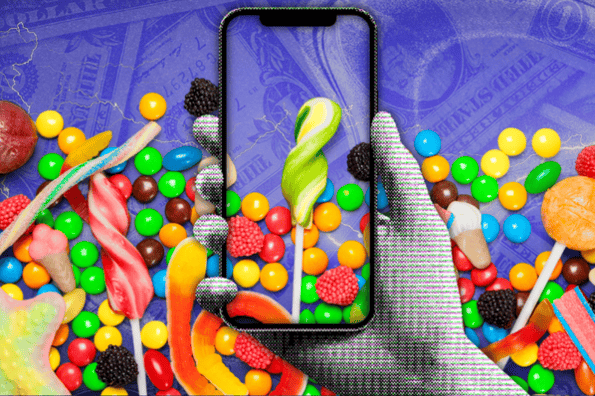Have you opened TikTok recently to a seemingly endless scroll of freeze-dried sour candies, sugar-coated fruit, and sets of bodiless hands packing boxes filled with colorful candy?

It’s not just the algorithm targeting your sweet tooth — there are tons of small businesses pedaling confections to captive audiences across social media platforms.
Despite inflation putting a squeeze on just-for-fun purchases for many American consumers, the global candy market was valued at $12.1B in 2022 and is estimated to be worth ~$15.1B by 2030.
And, in a time where consumers are increasingly turning to social media as an online shopping destination, savvy small businesses are meeting their customers where they are.
The hashtag #candy has 52.2B views to date on TikTok, while #sourcandy and #freezedriedcandy have garnered 1.1B and 2.9B views, respectively.
Space City Candy, a company specializing in freeze-dried candies, has witnessed the ebb and flow of social media trends firsthand.
“It came in waves… all of a sudden it would blow up on Facebook, and we’d get a rash of sales,” says owner Josh Riley. “Every cycle is getting bigger, and this cycle hasn’t ended and doesn’t look like it’s going to end anytime soon.”
The company, which began selling freeze-dried candy from its brick-and-mortar cupcake shop in 2020, saw shoppers driving from miles away just to buy its custom candy treats.
This inspired Riley to go all in on candy, opening a warehouse (with a second currently in the works) over the last two years to hold its industrial freeze dryers and large batches of wholesale candy.
Space City Candy freeze-dries all types of sugary treats, from Fruit Roll-Ups and Airheads to Starburst, marshmallows, and gummies, but its bestsellers are Skittles and taffy.
Riley says half of its business now comes from TikTok alone — with TikTok Shop making purchasing in-app even easier — and that followers on social media continue to pour in (the account is up to 18.4k followers).
The company receives so many orders that it often shuts its site down because the small team can’t fulfill orders fast enough. Today, they pack around 100 orders a day, with hopes of reaching 200 daily orders once the second warehouse opens.
“Our sales doubled, almost tripled,” says Riley. “Next year we’re hoping to do close to $1m.”
Seeing the social media sugar rush prompted candy companies who previously had no online presence to get into the game.
Candy Funhouse, a wholesale and retail candy business, launched its ecommerce arm in 2018 with a website and social media presence.
Today, the company’s TikTok has 3.4m followers and has earned 51.4m likes on its videos. On Instagram, 424k followers interact with the brand’s posts.
The brand identified one social media trend in particular to help launch itself to viral fame: ASMR (autonomous sensory meridian response, or the sensation some get by watching soothing videos and listening to sounds).
Playing on this trend, the company makes videos recording plastic platters being filled with various candies, often sorted by color or theme. The crinkling of the wrappers and clinking of hard candies hitting the plastic platters are music to ASMR enthusiasts’ ears.
And the company’s bet paid off: Single videos have racked up 59m views.
“Through research, we identified a niche interest in ASMR… We incorporated this concept into our content strategy through ASMR platters, showcasing some of the incredible brands we carry,” says CMO Dave Theodoropoulos. “The result has been nothing short of remarkable.”
It seems each week there’s a new social media trend for candy companies to play on: chamoy-drenched sugary treats; crunchy, candy-coated fruit; exploding, oversized jelly candy; or candy salads.
And the fact that this sugary side of social media not only exists, but also thrives, in a landscape often focused on idolizing healthy lifestyles, shows that viewers are hungry for a more nostalgic, sweeter option than what lifestyle influencers are promoting.
Social media allowed small candy businesses to compete in a crowded market. On grocery store shelves, only the big candy corporations of the world — like Hershey’s and Mars — can survive. For brick-and-mortar candy shops, it’s an uphill battle to get customers through the door.
But on TikTok or Instagram, broader trends can help catapult a candy brand to internet fame and, as a result, to financial success.
“The more followers you get, the more watches, views, and likes,” says Riley. “It’s a snowball effect.”



